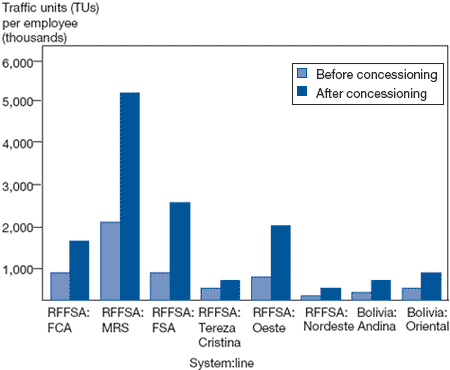PPI has enabled many governments to overcome long-standing problems of low labor productivity in public services. This has been done not only (and not even always) through reducing the work force but also through capital investment and service expansion.
All infrastructure operations can identify methods for measuring labor productivity and international benchmarks in the infrastructure sectors that are based on those methods. The practical use of those labor productivity measurements and benchmarks is less simple, however, because many circumstantial factors have to be taken into account. Improving labor productivity is a matter of combining quantitative information with qualitative judgment in the most effective ways. Module 3 addresses those issues more fully. For the purposes of this module, the issue to be stressed is that PPI typically is associated with increasing labor productivity measured in terms of output per employee. This is, in part, because labor productivity tends to be too low under state management.
Almost invariably, labor productivity measured in terms of output per employee rises following PPI. In many cases, employment reductions are one means of driving up productivity, and in some cases they are indispensable. Increasing labor productivity does not, however, necessarily involve job cuts, and even when it does, there are other productivity-enhancing measures to be taken as well (see box 2.7). In fact, other ways of increasing labor productivity can be more important than employment reduction. Badly designed retrenchment programs that lead to the wrong workers leaving (the adverse selection problem) or to mass demoralization can even have the effect of reducing labor productivity.
PPI affects labor productivity in a variety of ways.
Ravi Ramamurti has reported "explosive growth" in labor productivity in utilities and telecommunications following privatization in Latin America. It was achieved not necessarily through cutting jobs, but often through expansion of coverage, deployment of new technology, and other means. Even when employment numbers are sharply reduced, that is not the only factor in productivity increases.
Mexican telecoms increased the number of lines per employee by 13 percent a year in the first three years of privatization (which occurred in 1990), compared to a decline of two percent a year throughout the 1980s until the last two years before privatization when 10 percent increases were recorded each year.
Telecoms in República Bolivariana de Venezuela also recorded double-digit labor productivity increases in the first two years of privatization (beginning in 1991), and Argentina's lines per employee rose by 19 percent in the first three years after privatization (1990) compared with 6.5 percent in the two years before.
Ramamurti explained how it was done: "The dramatic increases in labor productivity resulted from a deliberate effort to freeze the size of the work force even as the network expanded by double digits. In Argentina, where workers were not promised job security after privatization, the new owners shed almost 50 percent of the original work force, even as they hired younger persons with skills in areas such as information systems or marketing; companies recovered the US$15,000–$20,000 spent on severance compensation per employee in two years or less."
Source: Ramamurti 1996b, pp. 26–28.
Other ways in which enterprise restructuring– through PPI or public sector modernization– brings labor productivity improvements include the following:
Of all the infrastructure sectors, railways have exhibited some of the highest levels of productivity improvements after PPI. This reflects the high level of surplus labor the railways have had to carry over the years and the subsequent high levels of work force downsizing. A review of six rail operations concluded that:
The most dramatic results of the involvement of the private sector in the concessions (or privatizations) are undoubtedly the significant improvements in labor productivity. In all but one case (Côte d'Ivoire/Burkina Faso–a 33 percent improvement in five years), labor output per employee (expressed as the sum of ton-km plus passenger-km per employee) at least doubled and more often tripled or quadrupled.
To some extent this was a result of traffic growth, but the greater share of the improvement must be attached to the programs which reduced the redundancy in the labor forces of the railways (Thompson, Budin, and Estache 2001, p. 10).
![]() Thompson, Budin, and Estache 2001.
Thompson, Budin, and Estache 2001.
Figure 2.2 shows traffic units per employee–the standard measure of labor productivity in rail–in six Brazilian and two Bolivian freight concessions before and after PPI.
Service expansion and capital investment form a substantial part of the productivity increase in some cases, such as Trinidad and Tobago Post (box 2.8). Another example is Côte d'Ivoire electricity, which was privatized in 1990. By 1995 labor productivity (kilowatt hours per employee) rose by nearly 25 percent. The number of consumers per employee showed a slightly slower rate of increase, from 128 in 1990 to 156.7 in 1995, a rise of about 22 percent. Over the same period the number of workers employed fell by less than 5 percent (ILO 1999b, Plane 1998).
Labor productivity improvements have been substantial following PPI in railways.

Figure 2.2: Labor Productivity in South American Rail Companies
Note: The table compares the Andean and Oriental lines of the Bolivian railway network, and six divisions of the Brazilian federal railways (RFFSA) system: the midwest (Ferrovia Centro Atlântica, FCA), the southeast (MRS Logistica-MRS), the south (Ferrovia Sul Atlântica, FSA), the Ferrovia Tereza Cristinia in Tubarão, the west (Oeste), and the north-east (Cia Ferroviária Nordeste).
Source: World Bank, Private Railways Operations Database.
Under the 1999 Postal Act, following poor performance by the public operator, Trinidad and Tobago Postal Corporation (TTPost) was created, in consultation with the trade unions. A management contract was awarded to New Zealand Post, intended to enhance the reach of the universal service in TTPost as well as to improve revenues, profits, and customer satisfaction; and reduce transit time.
According to World Bank reports TTPost has:
Source: ILO 2002.